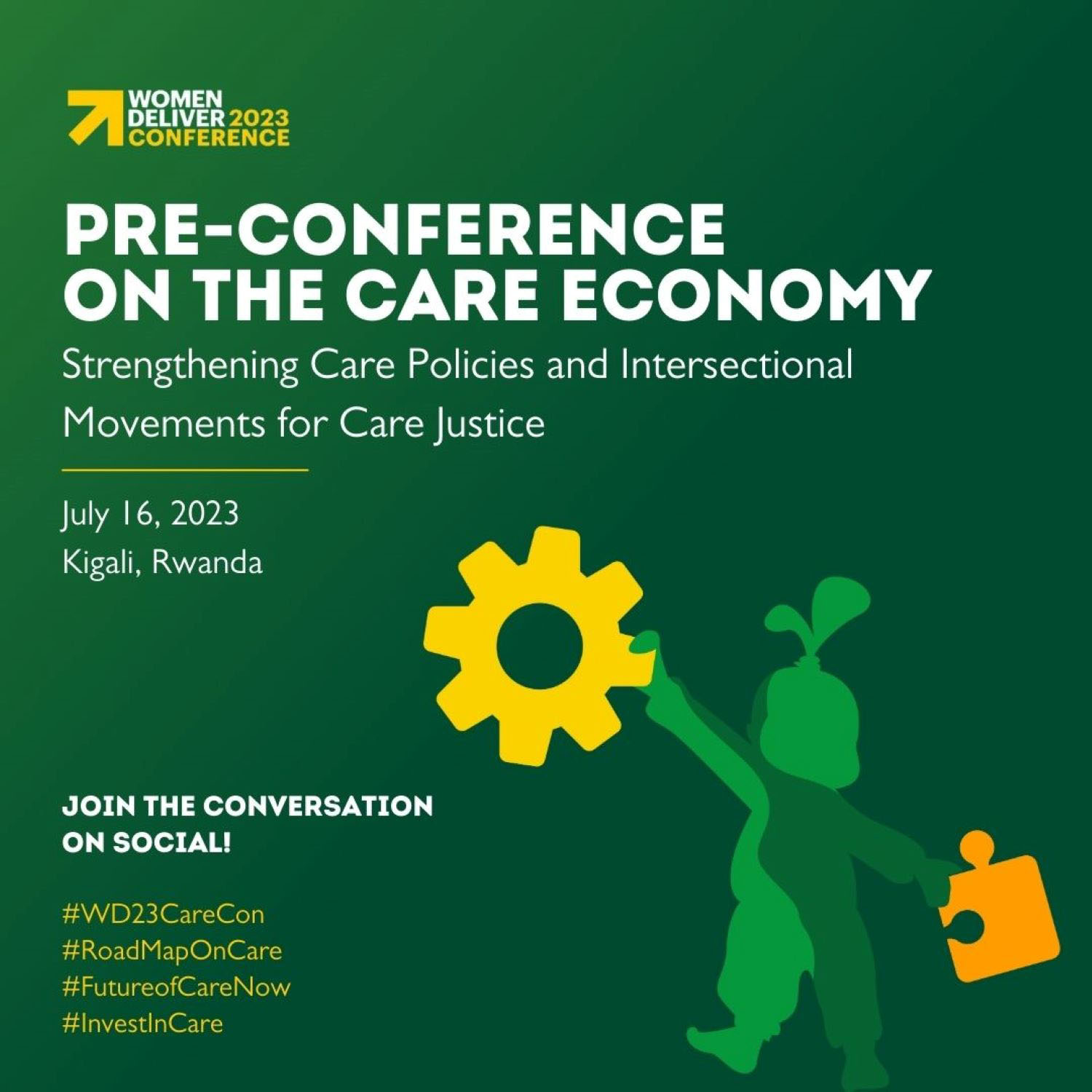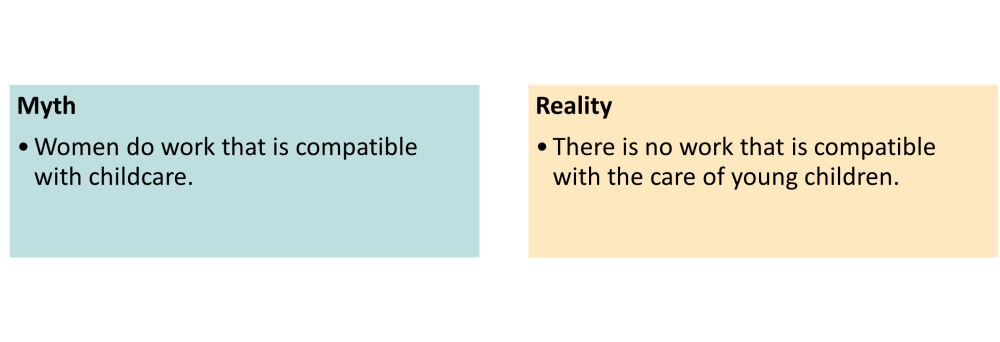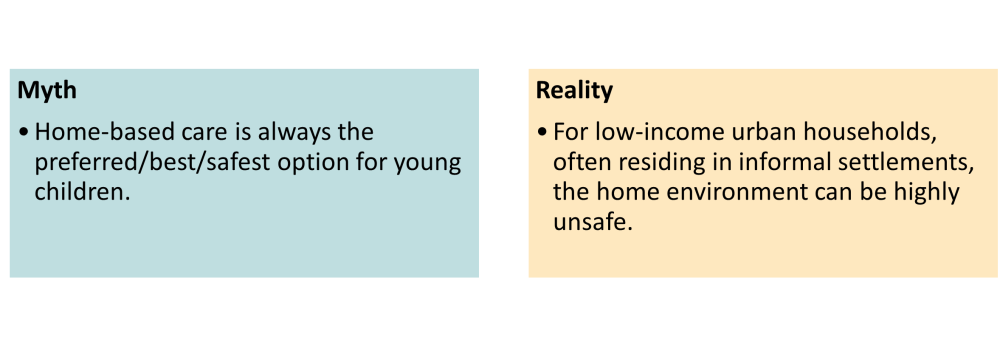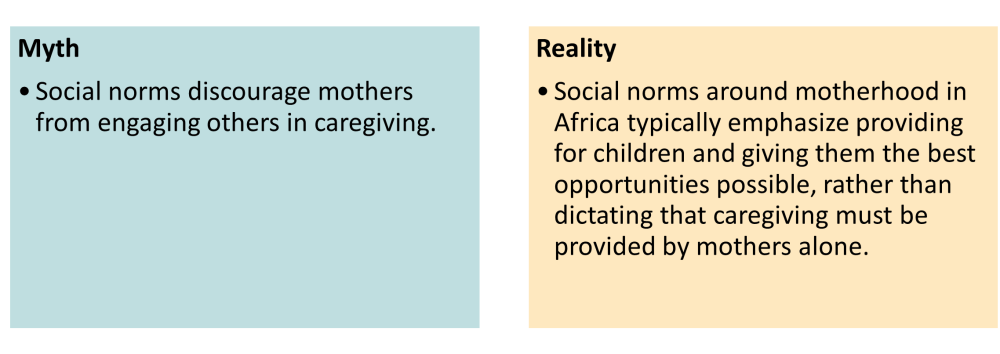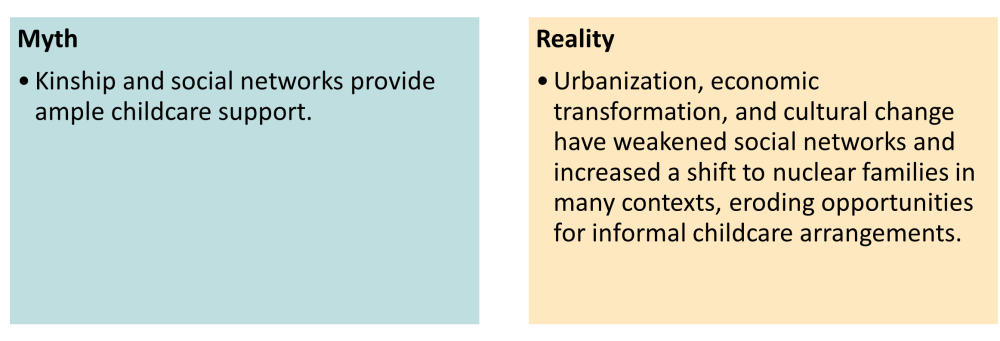Recommended

Event
VIRTUAL
November 09, 2023 10:00—11:00 AM ET / 3:00-4:00 PM GMT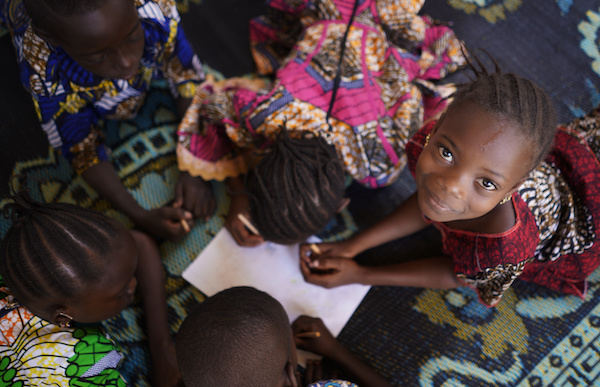
Blog Post
When discussing the connection between early childhood care (ECC) and women’s economic empowerment with policymakers, donors, and practitioners, we often come across five pervasive misconceptions dismissing the case for investing in ECC in Africa. Our research, however, tells a different story. We find and document a high demand for ECC, especially among low-income populations.
We outline these common myths below and describe the five contrasting realities that we have encountered in our work at CGD and the World Bank’s Africa Gender Innovation Lab. Our perspective is informed by existing evidence and our own ongoing qualitative research with a sample of urban mothers in Burkina Faso, complementing a prior study on the effects of childcare provision.
1. Childcare compatibility with work
Even if there were such things as “female jobs”, these would still be incompatible with caring for young children. Mina, a traditional cloth weaver who practices her craft from home explains that childcare duties continuously interrupt her work, adding on average 20 to 40% more time to perform her tasks: “Really it is disruptive. Often you want to take out your materials for weaving and the youngest will prevent you from working.” This exemplifies the “baby profit gap”, a phenomenon described by quantitative research, stemming from the lower productivity of female-owned businesses due to the distracting nature of childcare responsibilities. Moreover, qualitative and observational research from Ouagadougou has documented the physical and emotional toll experienced by caregivers (women) and their children when women simultaneously work and provide care. Natalia, a street vendor, explains the complexity of working while carrying her young child on her back. In addition to describing how her body aches from pedaling and carrying the child throughout the day, Natalia also talks about the physical strains on the child: “the child also suffers. When we carry him, his feet hurt, he cries, you are aware that he’s in pain.”
2. Home-based care
Given the conditions of low-income neighborhoods, leaving children momentarily unsupervised while caregivers attend to other responsibilities can be hazardous. Women in Ouagadougou express deep concerns about the safety of their children in their neighborhoods because of the surrounding physical infrastructure, or lack thereof. Families fear that their children would be hurt or killed by traffic or by drowning in open water sources. Furthermore, because of responsibilities related to domestic work and income-generating activities, primary caregivers (mothers) cannot confine and/or constantly supervise their children and they worry about them exiting the home and getting hurt or lost. Talice, who knits from home for a living, talked about how her daughter, who was not even 3-years-old, left the house compound unnoticed to join another child while Talice worked. When Talice realized her child was gone, the two children could not be found and the parents had to hire the service of a professional “crieur public,” someone who spreads news across the city, until they finally found the children in another neighborhood 3 kilometers away. Childcare center users talked about the relief associated with knowing that their children would be safe at the center and would remain there all day. Valerie explained, “If you entrust your child to a neighbor, you don’t know what they will do with your child. But if the child is in a childcare center, you feel secure. You know that the child will not go out and go somewhere.”
3. Social norms
Sociological analysis of traditional Yoruba culture reveals that “part of the Yoruba definition of motherhood was that mothers must provide for their children materially… motherhood was an impetus rather than an obstacle to economic activities.” (Oyewumi, p.73). Similarly, anthropological research on motherhood ideals among urban Asante market traders in Ghana and our ongoing qualitative study with a sample of urban mothers in Burkina Faso indicate that parenting norms in these contexts emphasize meeting children’s resource needs, rather than necessitating that mothers directly provide childcare. Childcare center users generally expect that they will receive praise from their social networks for investing in their children’s future by enrolling them early in educational institutions. Many mothers and fathers in Ouagadougou expressed that sending their children to creches helped make their children “éveillés” (a mix of being stimulated and more aware about the world). In the contexts of our research, we find that norms generally dictate that ensuring the care of young children is the responsibility of women, but it is acceptable for mothers to delegate that caregiving to others they trust, especially when care outside of the home provides educational and safety benefits to the child.
4. Social networks
Even if “it takes a village to raise children”, sometimes the “village” is simply not as available. Historically in many contexts in Africa, especially in rural settings, practices around household formation provided a broad pool of caregivers through arrangements such as multigenerational support, multiple mothers and wives in polygamous households, large extended family compounds, and multiple older siblings. Current day family arrangements by contrast often include migration to urban centers, away from a broader kinship network, and a shift toward nuclear families without readily available childcare support. This modern household structure leaves mothers to provide care with inadequate social support. For instance, Diana – a woman who can no longer afford to use a childcare center after her husband died – must now bring her two younger children to the waste dump where she collects items to salvage and resell. While Diana works, her 4-year-old daughter watches her toddler. Diana acknowledges that she would prefer not to bring her children with her to the dump given the hazardous environment. Yet, she has no choice because her relatives in Ouagadougou, who work and study, cannot provide reliable supervision for her children, and she does not trust their grandmother in the village to take proper care of them. Likewise, Cecelia explained that it is not possible to consistently access free care from your social network: “These days… you cannot care for someone’s child while she goes to look for money and meanwhile, she does not give you anything in return.” Researchers have documented similar limitations with kin networks and caregiving support in Kenya.
5. Childcare affordability
While a small minority of women in urban areas have high-paying salaried jobs with consistent earnings, most women engage in ad hoc informal employment, in low-earning economic activities (such as small-scale retail, food preparation, or personal services). Their income isn’t smooth or predictable. Thus, even in cases where access to low-cost childcare can increase women’s earnings, their income gains might not be substantial or reliable enough to enable them to afford the full cost of quality childcare on a regimented payment schedule. Fatoumata’s employment trajectory provides an illustrative case. Her first job after her oldest child was born was cleaning at a university, where she earned 25,000CFA per month (approximately $40), until the employer cut the hours and reduced the monthly pay to 20,000CFA. A neighbor cared for her child while she was at her cleaning job. She stopped work for a while when her second child arrived. Her next job was on a public works project, where her earnings were at their highest and she had access to the project-sponsored creche to meet her childcare needs. After the public works project ended, she no longer had access to childcare from a neighbor and the only job she could secure was as a cleaner in someone’s home. She split the job with her friend and they each took home 7,500CFA per month. She tried to supplement her earnings by offering ad hoc laundry services. She said that she and her child benefited from the creche, and she wished she could afford childcare, but she explained, “on 7,500CFA per month, how much am I going to deduct to pay someone to look after my child?” Recognizing that childcare is a public investment in future generations necessitates an awareness that it be communally provided instead of being entirely privately funded, particularly for low-income families.
The path forward
Moving from myth to reality is crucial for understanding the importance of promoting greater investment in childcare in Africa. The reality calls for an expansion of Africa’s ECC infrastructure to enhance the wellbeing of children and mothers in the region, especially for low-income households. Recent reviews of the effects of childcare interventions (published in Science and the World Bank Research Observer) have pointed to positive impacts on women’s economic outcomes. Moreover, studies have consistently documented high demand for childcare in several African contexts including the Democratic Republic of Congo, Ethiopia, Ghana, and South Africa. Building on research insights to develop evidence-based approaches to strengthen access to quality childcare services in Africa offers a promising path towards a brighter future for women, children, and society as a whole.
Disclaimer
CGD blog posts reflect the views of the authors, drawing on prior research and experience in their areas of expertise. CGD is a nonpartisan, independent organization and does not take institutional positions.
Image credit for social media/web: poco_bw / adobe stock


